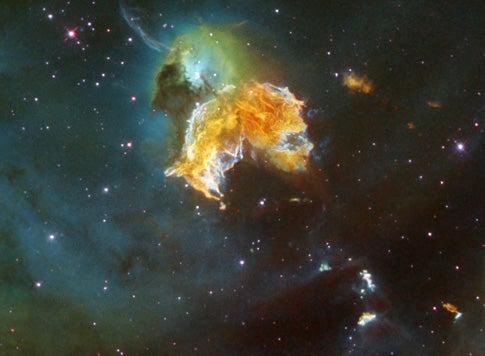The first step in forming a star is to get an interstellar cloud of gas and dust to collapse on itself. Astronomers have deduced several ways this could happen: a supernova shock wave, stellar winds or energetic radiation from massive stars, or a spiral arm density wave, to name a few.
For our solar system, a supernova seems, at the very least, to have been involved. The oldest solid objects in the solar system — inclusions found in some meteorites — contained several short-lived radioactive nuclei, including aluminum-26, calcium-41, and iron-60. All of these have half-lives of at most a few million years, and so must have been injected into the developing solar system at its beginning.
A team of planetary scientists led by Junya Miki from the University of Tokyo proposes the molecular cloud that gave birth to the Sun existed near a star containing more than 20 times the Sun’s mass. This heavyweight star then underwent a “mixing-fallback” supernova, in which the exploding star’s inner regions mixed. Some of this material got ejected, while the rest fell back on the collapsing core. Miki presented the team’s findings this week at the Lunar and Planetary Science Conference in Houston.
The researchers looked at two possible scenarios. In the first, the supernova’s shock wave would’ve compressed the molecular cloud, initiating the cloud’s collapse. The supernova’s ejecta, which contained the short-lived nuclei, was incorporated into the protostellar nebula. In the second, intense ultraviolet radiation from the massive star (and possible companions) would’ve already caused the cloud to collapse. The supernova then injected the radioactive elements into the protoplanetary disk.
In the first case, the exploding star had to be between 6 and 16 light-years away. Only at that range would the shock wave have been strong enough to compress the molecular cloud but not so strong as to shred it. The meteorite inclusions would have formed within about 1 million years after the molecular cloud’s collapse.
In the second case, the exploding star would be only 1 to 2.5 light-years away. (The smaller distance results from the protoplanetary disk being much smaller than the molecular cloud in the other case, so the supernova had to be closer to deliver an equal dose of radioactive elements.) Under these conditions, the meteorite inclusions likely formed a few million years after the disk.
The scientists admit it’s hard to decide which case is more plausible. However, Miki confesses he leans toward the more distant bang that would’ve both triggered the molecular cloud’s collapse and injected the radioactive elements.










